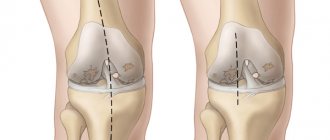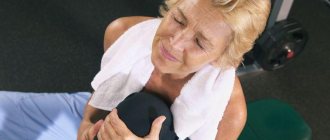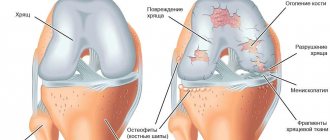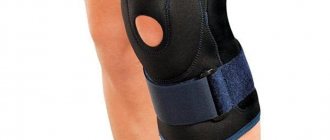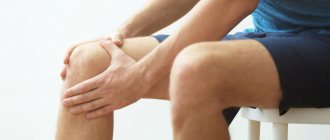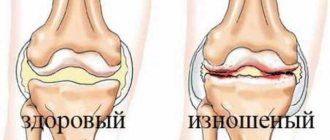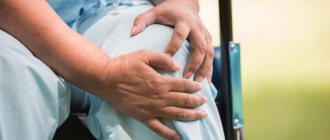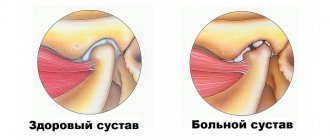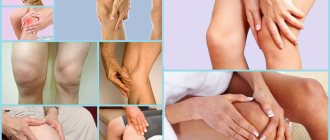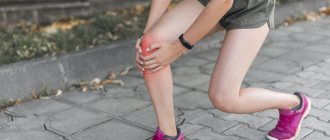Gonarthrosis is a chronic pathology of the knee joint, which causes destruction and thinning of the articular cartilage with further deformation of the articulating bone surfaces. The internal structures of the knee are gradually affected by degeneration: years (3-8 years) may pass from the onset of degenerative-dystrophic pathogenesis to the appearance of pronounced gonarthrosis. However, keep in mind that the progression of pathogenesis does not stand still; it, albeit slowly, moves forward.
Simplified image of the diagnosis.
The disease refers to the pathology of the musculoskeletal system. And if it is not stopped in a timely manner, even at the stage of insignificant changes (at stage 1 of gonarthrosis), drug and physical treatment will be difficult and not always productive. Unsuccessful conservative therapy, which is not uncommon even in cases of moderate severity, as well as the last stages of the disease, require only surgical treatment.
All non-surgical therapeutic tactics that are used in the fight against arthrosis in the knee are designed to reduce painful symptoms, strengthen muscles and improve the nutrition of cartilage, due to which it is possible to achieve remission of degenerative and dystrophic processes and some improvement in joint mobility. The conservative approach, unfortunately, is effective and advisable especially in the initial period of gonarthrosis. In advanced cases, it will not help; the patient will have to replace the critically modified knee joint with an endoprosthesis.
Therefore, it is so important to diagnose pathogenesis in time, before it causes significant damage to functionally significant structures. Having heard from a doctor a diagnosis of “grade 1 gonarthrosis”, it is necessary to take on the problem seriously and irrevocably, and not let it slip away from qualified control. At the initial stage, the disease responds well to preventive treatment, which will allow you to avoid encountering its serious consequences. The consequence of advanced arthrosis is terrible chronic pain in the joint, loss of mobility and serious deformities of the knee. To prevent you from being affected by such a clinic that leads to disability, we suggest that you carefully study the material below.
Early symptoms
Try to be attentive to the signals that your body sends you, indicating a clear disorder in the knee joint. And the first of these alarm bells is a nagging, aching pain in this area of any intensity. If you experience such a symptom, go to the hospital immediately! Pain is a common sign of impaired metabolism in osteochondral tissues, deficiency of cartilage nutrition and its incipient destruction.
The first symptom is pain.
What other signs may most likely indicate the onset of development of degenerative-dystrophic processes in one of the main movable bone joints of the lower limb? So, the early manifestations of gonarthrosis of the knee joints include:
- a feeling of slight stiffness and/or pain in the joint after a long walk, long physical activity, and after rest the disappearance of these symptoms;
- stiffness of the knee (it can be combined with pain) after a long stay in a stationary state, for example, after sleep or a long stay in a sitting position, which is felt from the first steps and goes away on its own as soon as you move away;
- mild or moderate crepitus of the joint, characterized by any sounds that the patient hears in the knee region during movement (crunching, creaking, clicking, crackling), however, this symptom is mainly common in the middle stage.
It is not recommended to prescribe medication for yourself, since treatment and preventive measures should be carried out by a highly qualified specialist based on diagnostic data, the etiology of the disease and the individual characteristics of the patient’s body. In addition, it is not enough to “extinguish” pain with common non-steroidal anti-inflammatory drugs; in treatment, it is extremely important to correctly develop the most effective treatment program. It involves a multi-complex individual approach, including a combination of exercise therapy with physiotherapeutic, medicinal, nutritional and massage techniques.
If your knee hurts, this does not always mean that the problem is there, so do not rush to apply ointments and take pills, but see a good doctor.
Without adequate comprehensive therapy, which is strongly recommended to begin as early as possible (ideally at stage 1), the disease will simply turn you into a frail and disabled person.
Signs of gonarthrosis
- joint stiffness, limited mobility
- a rough, distinct crunching sound when bending and extending the leg at the knee, sometimes when walking (caused by deformation of the articular surfaces and marginal osteophytes)
- fast fatiguability
- pain after rest (in the morning, after prolonged sitting or lying), long walking
- short-term aches in the joints (usually occurs with senile gonarthrosis), which intensifies in bad weather
- joint deformation (bone tissue thickens due to osteophytes, it seems that it is growing).
Causes
Pathogenesis can be secondary or primary (idiopathic). Secondary gonarthrosis is preceded by certain pathological conditions, that is, it does not develop on its own, but against the background of one or another completely understandable cause, and usually only one joint is affected. To date, experts have not yet determined the exact nature of the origin of the primary disease. Idiopathic gonarthrosis in clinical practice is a non-common form, predominantly of bilateral localization (two knees are affected at once), more often found in the elderly category of patients.
Bilateral gonarthrosis on x-ray.
So, the damaging factors that contribute to the launch of the degenerative-dystrophic process in articular cartilage are as follows:
- traumas suffered in the distant or near past;
- regular overload of the joint (domestic, sports, professional);
- systemic diseases - rheumatism, gout, psoriasis, lupus erythematosus, etc.;
- discrepancy between the level of physical activity and age;
- advanced arthritic disease of any etiology;
- general metabolic disorder in the body and excess weight;
- congenital failure of the ligamentous apparatus;
- congenital anomalies of the structure of the knee joint;
- various orthopedic disorders, for example, curvature of the spine,
- deformation of the feet, etc.;
- endocrine disorders - diabetes mellitus, thyroid dysfunction,
- adrenal insufficiency, etc.
This is what the destruction of cartilage tissue looks like in real life.
People of any age are susceptible to the disease, sometimes it develops even in adolescents and children; fortunately, this happens in isolated cases. Quite often, athletes and people in difficult professions suffer from gonarthrosis, due to the fact that their knee department endures high loads every day, which in turn increases the risk of leg injuries. The highest incidence rate was recorded in women; men have a lower predisposition to gonarthrosis pathology.
Knee replacement in the Czech Republic: guarantees, prices, rehabilitation, reviews and statistics.
Find out more
Basic principle of therapy
Treatment of gonarthrosis is a complex of treatment and preventive measures specially selected by a specialist for a particular patient, which takes into account the etiological specificity of arthrosis, the severity of clinical manifestations, concomitant diseases, age characteristics, weight and anamnestic data. Therapeutic measures are planned only after a thorough diagnosis of the patient. At stage 1, the treatment process is developed in such a way as to specifically influence:
- elimination of pain syndrome;
- improved nutrition of cartilage tissue;
- activation of local blood flow;
- optimization of beneficial load on the joint;
- strengthening and normalizing the tone of surrounding muscles;
- restoration of motor-support functions of the joint.
Similar goals are pursued in the 2nd stage, when a conservative approach is still appropriate, although achieving them will be much more difficult. Methodological methods for treating grade 1 gonarthrosis, regardless of its type and the number of affected joints, are based on the use of such health-improving tactics as:
- therapeutic exercises, the basis of which is a set of exercises to develop the joint without direct load on it (trainings are carried out strictly according to the instructions of the trainer, preferably under his supervision!);
- diet is an equally important part of the treatment strategy; it involves correcting the patient’s weight and restoring the vitamin and mineral balance in the body through proper organization of the diet;
- physiotherapeutic procedures (laser, magnet, therapeutic mud), massage, manual therapy, which will improve blood circulation and cellular metabolism, stimulate the natural production of biologically active substances in bone and cartilage structures, restore muscle fibers and ligaments, relieve swelling and pain;
- the use of medications from the group of chondroprotectors (Arthra, Dona, Teraflex, etc.) to improve metabolic processes at the local level, eliminate nutritional deficiencies in articular cartilage and bone tissue, which will prevent the progression of degeneration;
- the use of non-steroidal drugs against painful sensations in the form of ointments, creams, sometimes in the form of tablets and injections, however, in tablet and injection formulations, as a rule, there is no need, since the pain syndrome at the early stage is short-lived and not severe;
- therapy with folk remedies, dietary supplements and unconventional methods - such tactics should be considered only as an addition to the main treatment, and it is prohibited to use them without permission without consulting a doctor.
It is better to prevent a disease than to treat it. Lose weight, visit health resorts and lead an active lifestyle.
It is very useful to undergo health improvement (1-2 times a year) in specialized sanatoriums. For patients with gonarthrosis, sanatorium-resort treatment is mandatory. It involves undergoing a procedural course of diadynamic therapy, peloid therapy, balneotherapy, amplipulse therapy, interference therapy and other therapeutic sessions that have a great effect on the morphology of articular and periarticular tissues. Such incredibly productive procedures are not offered in regular outpatient settings.
Diagnostics
Gonarthrosis is diagnosed by a traumatologist-orthopedist or surgeon. Initially, a detailed medical examination and x-ray are performed.
During the initial examination, signs can be detected only at stages 2 and 3 of the pathology due to deformation of bones and joints, curvature of the limbs of the bone and roughness of its contours. Palpation allows us to understand the presence and nature of pain.
Radiography is one of the classical examination methods. It makes it possible to clarify the diagnosis and differentiate it from other pathologies, gives an idea of the depth of the lesions and the dynamics of the development of the process. In this case, the initial stage is usually difficult to see. In older people, changes are present due to age and, in the absence of clinical symptoms, do not lead to a diagnosis of gonarthrosis.
Modern research methods are CT and MRI, which are used extremely rarely.
What are the dangers of lack of treatment?
If treatment is ignored, the pathology will gradually destroy the hyaline cartilage covering the ends of the articular bones, which will cause compaction of the subcartilaginous areas, the formation of rough bone spines (osteophytes), narrowing of the joint space and pathological friction of bone surfaces against each other. Thus, the knee will undergo severe deformations, which will make moving excruciatingly painful and very difficult, since there will be a pronounced curvature of the bone axis and failure of flexion/extension functions. You can no longer do without a cane or crutches.
What's next? And then the pain syndrome will only intensify, in addition, it will become constant, even at rest. The muscle structures that should move the joint will undergo atrophy due to limited mobility of the leg. The neglected pathology will eventually lead to the fusion of the curved epiphyses of the articular bones and the complete ossification of the once mobile joint, that is, to its absolute blocking.
No non-invasive or minimally invasive methods, including all medications, even stem technologies, are completely ineffective in severe gonarthrosis, and sometimes even in its second stage. It’s better not to mention cellular technologies at all, because to date they have not proven their effectiveness in relation to osteochondral anatomical structures. The only remedy that is reliably capable of radically solving a complex medical problem is knee replacement, that is, replacing a dysfunctional one with an artificial implant.
Early diagnosis and timely prevention are the two best ways to combat the disease. There is no need to wait for anything if your knee is bothering you; it is better to quickly stop gonarthrosis than to allow it to destroy and bend your knee joints to such an extent that you cannot simply walk without assistance or crutches.
Yes, you will have meetings with a rheumatologist, orthopedist-traumatologist or neurologist with periodic regularity; you will be required to strictly adhere to each course of special therapy prescribed by a specialist, but this is the only way to prevent the progression of a dangerous disease and maintain freedom of movement for many years.
Knee replacement in the Czech Republic: guarantees, prices, rehabilitation, reviews and statistics.
Find out more
Symptoms
Arthrosis is a slowly progressive disease that in itself never causes changes in blood counts (for example, ESR), an increase in body temperature or other clearly noticeable characteristic signs. It is noteworthy that the degree of pain and limitation of joint mobility does not directly depend on morphological changes. That is, one patient may have severe pain even with minor cartilage degeneration, while another may have virtually no pain even with pronounced changes, clearly visible on X-rays, MRI or CT, or ultrasound. The fact is that there are no nerve endings or blood vessels in cartilage. Therefore, symptoms appear only when changes begin in other tissues.
Classification in ICD-10
The ICD-10 code is an alphanumeric designation of a disease, taking into account its class, type, genesis and clinical features, which is included in the list of the International Classification of Diseases, 10th revision. The ICD regulatory document includes codes for all diseases known to medicine, which makes it possible to conduct statistical analysis of morbidity and mortality for a specific disease in an international format, adhere to a unified diagnostic system and methodological approaches to treatment.
Such a serious pathology of the musculoskeletal system as deforming osteoarthritis (DOA) of the knee joint, also known as gonarthrosis, also has a code according to ICD-10. According to the International Classification System, this pathology is assigned the general code M17:
- the letter “M” says that the disease belongs to the class of diseases of the musculoskeletal system and connective tissue;
- the number “17” indicates that this is an arthrosis-type disease, and it is localized specifically in the knee region.
Depending on the type of DOA of the knee and the number of diseased joints, the M17 coding is supplemented with one number from the range 0-9. For example, M17.0 is primary bilateral gonarthrosis; M17.1 – primary one-sided; M 17.2 and M17.3 – post-traumatic type gonarthrosis of bilateral (after the point “2”) and unilateral (after the point “3”) localization, M17.4 and M17.5 – secondary unilateral and bilateral arthrosis of the knee joint.
The code, presented in the form of an alphanumeric symbol, is convenient in terms of transmitting, storing information, exchanging disease data, and entering an accurate diagnosis into various medical documents, since such a short but very informative combination eliminates the need to use long verbal formulations. Practical use of the code system is widespread throughout the world among medical professionals and health authorities.
medi products
Orthoses that correct the position of the knee joint can be an effective alternative to endoprosthetics and pain medications.
Knee braces and orthoses: Genumedi, Collamed OA, M.3s OA and M.4s OA can be used to treat gonarthrosis at different stages.
The role of diet and exercise
With arthrosis of the knee joints at the initial stage, it is important to know that the most important methods in your case are therapeutic exercises and normalization of the diet. The doctor may not even prescribe medications to you (not always), but will give you competent instructions on how to treat the emerging pathogenesis only through a unique set of exercises and a certain diet. And thanks to these two paramount methods, which you will follow responsibly, you can really achieve excellent results. If you do not do the physical exercises prescribed by your doctor and follow dietary rules, then there is very little chance that you will heal your knee.
Both physical training and diet and nutrition regimen are developed on an individual basis, so it would be wrong on our part to tell you right now, “do this and that, and you will get better.” But we can give some valuable advice. So, when it comes to the daily menu, first of all, the patient must adhere to the rules presented below.
- Reduce your salt intake, as it is a strong irritant to bones and cartilage, and also leads to the accumulation of excess fluid in the joints, which is not good.
- Eliminate from your diet products in the form of all kinds of semi-finished products (sausages, sausages, sausages, processed cheese, etc.). Such delicious products are saturated with harmful preservatives and flavor enhancers, which are among the provocateurs of complex metabolic disorders not only in the joint, but also in other organs and systems of the body.
- Give preference to natural products, vegetables, fruits, boiled or steamed meat from dietary varieties. It is extremely beneficial for you to eat various cereals, especially buckwheat. But it is better not to use semolina and rice cereals in cooking.
- Fermented milk products of medium fat content, jelly-like dishes (jellied meat, jelly, natural jelly, etc.), greens, fish and seafood, almonds, legumes, and whole grain bread will be beneficial.
- Avoid fatty foods, do not abuse flour and sweets, soda, alcohol and fast foods, these are the first provocateurs of obesity. High body weight creates an additional load on the lower limbs that does not correspond to physiological norms, which will only worsen the condition of the functional units of the knee.
- Eat small meals, but often. It is better to divide the daily meal into 5 or 6 meals.
Now let's say a few words about physical education. It should be regular and dosed, and correspond specifically to your problem.
- In any case, you should not walk for a long time, swing your legs, do full squats or run.
- Effective exercises include the well-known “scissors” and “bicycle”, which are performed while lying on your back.
- Experts also recommend alternately lifting each leg above the floor (a distance of 25-30 cm) with a five-second delay at the top point. To implement this task, you need to initially lie on your back.
- Certain exercises on knee flexion and extension must be included. They are performed lying on the back and stomach, standing and sitting.
- Free swimming in the pool has a very beneficial effect. Swimming is not only possible, but even necessary for people with this diagnosis.
Attention! We emphasize that physical therapy exercises and diet are not just temporary events, but your integral companions throughout your life! Impeccably organized daily physical activity and diet at stage 1 of the disease will allow a person to prevent further destruction of cartilage and maintain normal biomechanical functions of the limb.
Prevention
Preventive measures for gonarthrosis are of great importance as part of preventive therapy. Such events include:
- maintaining body weight at an average level;
- training the muscles of the lower extremities;
- avoiding joint injury;
- timely treatment of inflammation in the joints;
- moderation and strength of physical activity;
- compliance with the rules of a healthy lifestyle - proper nutrition, activity in accordance with the age limit, adherence to sleep and rest patterns;
- strengthening the immune system.

